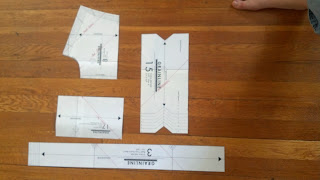Unfinished from last winter is Gertie's coat - Butterick 5824. I have a bodice muslin that fits well after a few alterations. The fabric is a discount wool houndstooth purchased at Sew Low Discount fabrics in Cambridge, Ma. The poly charmeuse lining was also purchased there.
I want to interline the bodice for warmth, and purchased 2 yards of sew-in Pellon Thermolam. I've read up on different techniques this
here. I plan to try the second technique, and baste the Thermolam inside the garment fabric after sewing it up. For me, this is preferable to underlining because I do not want to add bulk to the seams. I also didn't want to try quilting the Thermolam to the lining, because I don't like the look of a quilted lining on a formal coat.
I took the wool to my dry cleaner to steam, so that it would not shrink. It was $25!! I won't be doing that again any time soon. My other woolens I have steamed with the iron at home, but with 7 yards of 60" wide fabric, I decided to spring for the dry cleaner. I took it home, and patiently cut out 3/4 of the garment fabric, including adding tailor's tacks - but stopped when the weather started getting warm.
Now that it's fall once again, I'm tempted to start on this one. I am terrified to attempt making a coat, but with the ease of kimono-sleeves this should be a good introductory garment. I'm familiar with basic linings and bound buttonholes from other projects. The new-to-me techniques are the collar, and the interlining. This UFO seems simpler than the jacket in my last post.











